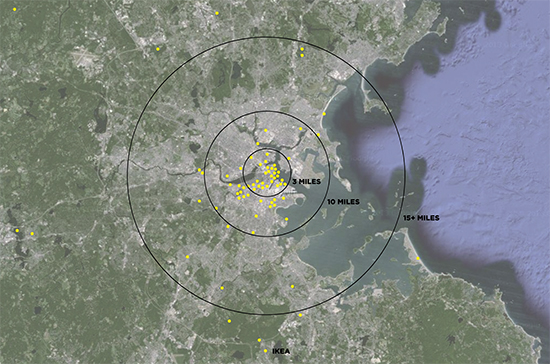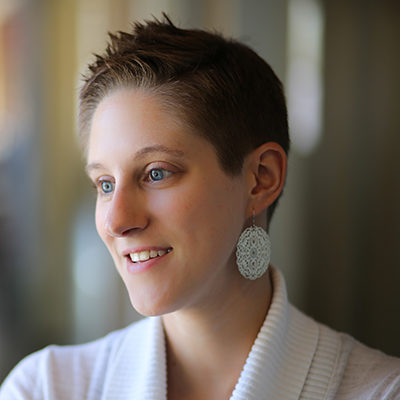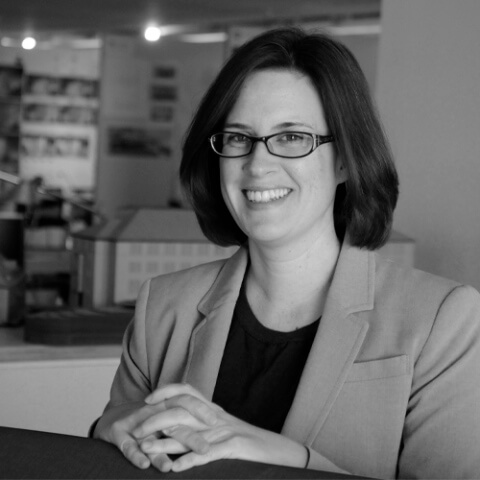PAYETTE’s office is located in downtown Boston, just down the street from South Station. Many of us commute to work via public transportation, bikes or on foot. A few of us were discussing our decision to live car-free recently and discovered a few key themes. There is an appeal to living without a car; it’s less expensive, it reduces your carbon footprint and it forces you to walk more. The three of us discuss the common themes we discovered; Kerry Drake (KD), Karen Robichaud (KR) and Matthew Fickett (MF).
![]()
The Choice to Live Car Free
KD: I was born and raised in Southern California. There, as in most suburban parts of this country, a car is the primary means of getting around. Drive to work, school, the grocery store, etc. Everything is so spread out, which makes walking impossible and public transportation routes few and far between.
When we (my boyfriend Ben and I) decided to move to Boston, we chose to live car free downtown in the West End: “If you lived here you’d be home by now.” We planned to walk to work, and figured that we could take public transportation everywhere else. Discovering that parking cost $350/month extra on top of our pricey high-rise rent sealed the deal. Our lives totally changed in ways we did not expect. Living without a car has been an amazing, frustrating and an eye-opening experience.
KR: I grew up in the suburbs of Boston and led a very car-centric childhood. However, post-college when I worked in Downtown Crossing and lived in Brookline, I didn’t really need a car. At least, not like I’d needed one during my childhood. It was an easy choice because I couldn’t really afford to park, maintain and care for something I’d, at best, only use on weekends. I live within a half mile of the nearest grocery, there are a couple T and bus stops within a mile and I’m really close to a library. I’ve found living car-free to be really liberating.
MF: Up through middle school, I lived in a small town (less than 20,000 people) in the middle of the desert in New Mexico. I biked everywhere – to the library and to elementary school – on my own. Then, when I was in high school, we moved to the suburbs outside of Philadelphia, and suddenly I couldn’t go anywhere without someone’s parents giving us a ride. When I had the opportunity to choose where I wanted to live, my only criteria was that I could live car-free. Boston fit that requirement well. Now my wife and I live in Cambridge, which is very friendly to bicycles and pedestrians.
In the last year I’ve been doing my best to live without any form of mechanized transportation. So far in 2014 I’ve taken the T less than half a dozen times.

Changing Scale
KD: We found that our world got a lot smaller, and took a lot of getting used to. The positive side: human scale living – using resources available to you within a three mile radius. The negative: not being able to get places beyond a three mile radius. Natick Mall … where’s that? (On the moon, as far as I can tell.) A round trip to the Container Store (including shopping and lunch) was 3 ½ hours. We only did it once.
KR: I only start to feel the smallness of a car-free life in the winter. After months of scurrying to shelter on my commute, I start to long for a change of scenery. Because I grew up in this area, I have a sense of where more things are and I have deep roots in the region so if I really want to spend an afternoon at the mythical Natick Mall, I can call a friend from my childhood.
MF: Never having lived a car-centric lifestyle as an adult, I don’t know what I’m missing. In my youth, I needed an adult to give me a ride to somewhere far away; now I need a Zipcar. Things more than five miles away have always been exotic destinations to me. Oddly, it would be easier for me to get to downtown London from my house than to western Massachusetts.

Assuming a comfortable walking distance of 3-5 miles, using our office as the central point, we mapped what kinds of places we could easily access. In that 3 mile radius there are 25 CVS stores and 6 Marshall’s. The aquarium is centrally located as are a number of museums. The T only covers the first 5-10 miles beyond our center and the locations further out are less densely served by the T. Accessing big box stores like Ikea require a car.
Shopping/Consumerism
KD: Online shopping is really handy. I am always looking for who has free shipping deals. Also, it’s amazing what a wide variety of things you can actually buy at CVS, Marshalls and Macy’s. When you don’t have easy access to suburban “big box” stores (Ikea, Costco, Home Depot, etc.) you start to adapt.
KR: I use Zipcar when I want/need to go somewhere for a big item I can’t carry. While Zipcar makes my car-free life easy, it irks that I pay by the hour to have a car sit in a parking lot while I run errands.
MF: I’m with Karen – I’m waiting for the day when Google’s self-driving cars merge with Zipcar, and we never have to pay for a car we’re not using again. In the meantime, I buy everything I can online. Fortunately we live a few minutes’ walk from a grocery store, so it’s easy to walk to that.
Environment
KD: Walking does not burn fossil fuels or use heavy metals. However, I have burned through a lot of calories and couple of pairs of shoes!
KR: My impact on the environment was not my first priority when I decided to give up my car; it was primarily a financial decision.
MF: I like that I don’t depend on anything else to get somewhere. I’m flexible: I always have my feet, so it doesn’t matter to me if a bus isn’t coming, the T is stalled, or no one can find a cab. I never have to worry about where to park. However, the fact that I’m not depending on anything means that I have very little impact on the world from an energy-consumption point of view, and I certainly like that. I can feel good that I’m not contributing even a little bit to use of gas or electricity when I go from place to place. It gets to the point that I am uncomfortably aware of the extravagant use of energy when I do have a rare ride in a car.
Exercise
KD: Walking, walking, walking – typically several miles a day. It’s great exercise, and you get to spend a lot of time appreciating architecture, little local shops, and just being outdoors.
KR: I love a long walk; it’s how I decompress. I am content to walk to meet a friend and not owning a car just pushes me to do that more frequently. Visiting walkable cities is actually a priority when I’m planning a vacation.
MF: The more I walk, the more I like to walk. I’ve been pushing myself to see farther and farther places as walkable. This week I walked from work to my brother’s house in Brighton. Only two Green Line trains passed me on Comm Ave, so I knew that I actually wasn’t spending much extra time by traveling this way! My “comfortably walkable” radius on the map is starting to approach 5 miles.

The Daily Commute
KD: My commute vehicles: a backpack and (occasionally) a rolling cart. I never have to sit in highway traffic. Traffic? What’s traffic? However, there is occasionally “the death march” – that mile walk to the T, when it’s late, or pouring.
Here’s a strange setback I didn’t expect: Getting a job offer in the suburbs. During my job search process, a recruiter called me with a potential job in Framingham. When she found out I didn’t have a car, she told me never mind – I wouldn’t be able to get there. Luckily there are lots of great companies downtown!
KR: Commuting is a huge pet-peeve for me. I think it’s the worst use of time regardless of mode of transportation. However, a lot of that frustration is wrapped up in feeling like I’m running late or that my transportation is out of my control, which can happen on public transportation or in a car. Generally when I’m walking I feel more relaxed. When I am on the T, I try to keep a good book handy so that I won’t notice as much when the train stops every 20 feet. Per Kerry’s point about working outside the city; I always factor in commuting time and how easy it will be. I’m not eager to transfer buses/trains daily. I also check the Red Sox game schedule so that I don’t end up on the green line during the rush to the game.
MF: Karen’s point is my biggest regret. When I took the T, I could read every day for 45 minutes each way (or more; the breakage-prone Green Line was secretly my favorite). Now I spend that time walking, so I can’t read. Instead I try to push myself to do more elaborate three-dimensional design exercises (mechanical coordination, anyone?) in my head while I walk, or on less ambitious days I just try to look around and learn something new about the city.
When You Need a Car
KD: We usually rent a car when we feel the need to get out of the city.
The rental car experience: Walk to Gov’t Center > Ride Blue Line > Ride Airport Shuttle > Pick up Rental Car > Drive around until you’re blue in the face > Return Rental Car > Ride Airport Shuttle > Ride Blue Line > Walk home from Gov’t Center. It works, but you have to plan your day.
For short trips, we use Zipcar, taxis and occasionally bum rides.
KR: I’m a huge fan of Zipcar for running errands and try to make an afternoon or a day of it, saving up all my tasks for one mega-trip. Sometimes I’ll get a ride from friends or family. I generally don’t enjoy taking taxi and for the first few years out of school I worked in an entry level position at a non-profit, so I had very little disposable income to spend on such luxuries as a taxi ride from Cambridge to Brookline.
MF: Zipcar is great and very convenient for trips to IKEA or other short trips. The first time we rented a car to go out of town I couldn’t believe how elaborate it was in comparison!
Groceries
KD: They get their own category! I am lucky enough to live by a grocery store – it’s Whole Foods. I love their products, but the prices are super expensive. Fortunately, I discovered home delivery. For about $7 the Peapod truck shows up at my door with bags of groceries. It’s great!
KR: I definitely think grocery shopping becomes the biggest challenge when you live car-free (and bike-free in my case). It’s mundane and happens so frequently that it feels like the most burdensome of chores. Sometimes I’ll grab a Zipcar for an hour if there’s one available in the lot behind my building. If there isn’t, I schlep to the store.
MF: Groceries are very easy for me right now (1/4 mile from my house), but that’s about to change. We’re about to move to the suburbs, and the nearest grocery will be more than two miles away. That’s a long walk with groceries, but I’m going to see if we can do it on our bikes. That may get rough in the winter though!
Hobbies: Excursions, Outdoor Sports, Arts and Crafts
KD: Ben really missed having a garage to work in. We have discovered the Artisan’s Asylum “hackerspace” which has tons of classes, tools and workspace: saws, welding equipment, CNC machines, you name it.
I have come to realize how hard it is for people without a car (such as low income families) to enjoy “the great outdoors.” I have heard about outdoor programs for urban school children such as overnight camps, mobile petting zoos, etc. – but now it really hit home.
Some activities that are pretty hard to do without a car:
Hiking, camping, and skiing
Visiting a farm
Archery – we sewed up a cover for Ben’s bow so it didn’t look like we were about to attack the Blue Line, medieval style.
Scuba diving – luckily the taxi driver didn’t ask too many questions about our soggy gear.
Transporting large or heavy items, like furniture or construction materials.
KR: When it comes to hobbies and cars, I don’t have any issues. I prefer museums, libraries, movies … all things I can do in and around Boston. Occasionally I’ve utilized the commuter rail system and I’ve also traveled with friends who do have cars.
MF: We’re buying a house, which sounds like the ultimate “arts and crafts” justification for a car. I’m not sure how to carry a sheet of plywood home on my bike. It’s looking grim for a car-free existence!
Conclusions
Living car-free is definitely a viable lifestyle in a walkable urban area like Boston. There are many amenities available like Zipcar and grocery delivery that makes modern life convenient. Whether your personal priorities are getting exercise, helping the environment, participating in urban culture or saving money, eliminating a car from your life can definitely improve your lifestyle. The frustrations we have faced should be seen a challenge to improve ourselves and the urban landscape. We look forward to hearing Matthew’s story, as he brings his car-free outlook to his new suburban home.
Related
What Millennials Want — And Why Cities Are Right to Pay So Much Attention




